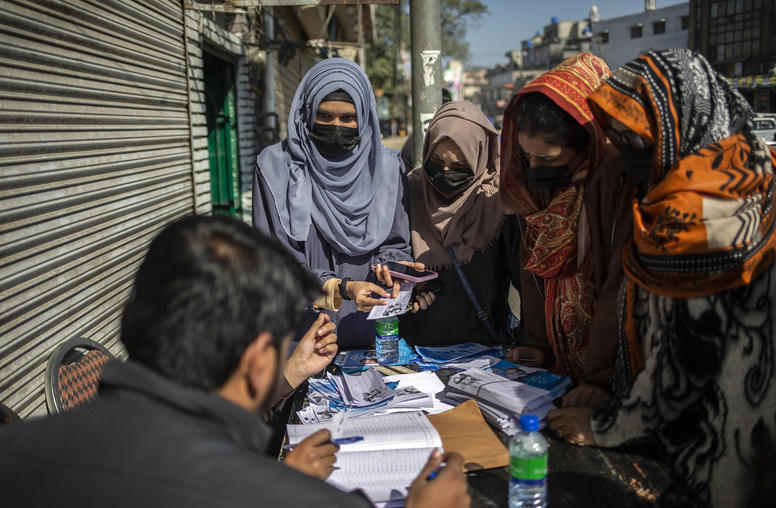President Obama Calls for Troop Drawdown
President Barack Obama announced he would bring home 33,000 troops from Afghanistan by the end of next summer, thus ending the surge he announced at West Point in 2009.
June 23, 2011
OBAMA BEGINS DRAWDOWN – President Barack Obama announced June 22 he would bring 10,000 American troops home by December and the remaining 23,000 “surge” troops back by the end of next summer, thus ending the surge he announced at West Point in 2009. It’s a more aggressive drawdown than some of his military advisers had wanted, representing a political compromise at a time of escalating war costs and mounting debt, experts say. President Obama stressed that even as the drawdown unfolds over the next year, political reconciliation in Afghanistan will occur simultaneously. “Peace cannot come to a land that has known so much war without a political settlement,” he said in the White House East Room. “As we strengthen the Afghan government and security forces, America will join initiatives that reconcile the Afghan people, including the Taliban.”
OBAMA STICKING WITH THE SURGE? – USIP’s Moeed Yusuf says that even though Obama is drawing down, he is in effect maintaining the bulk of the surge for many more months. And even after all surge forces return home, a force of roughly 68,000 troops will remain – still far more than were on the ground under President George W. Bush. “It’s as good as he could have got it,” Yusuf says. “He signaled that we’re not dumping Afghanistan, but also that we’re not going to be there forever, and we have to find some kind of solution.” Despite the significance of the drawdown announcement, the quiet fact is that Obama is also sending a signal that the U.S. isn’t going anywhere anytime soon. “Even at the end of 33,000, it’s still going to be 68,000 troops,” Yusuf says. White House officials believe the security gains achieved under the surge over the last year can be maintained, using the remainder of the surge forces through next summer and the rest of the force through 2014, when the full transition of security responsibility falls to the Afghans.
RECONCILIATION TALKS TO UNFOLD – Settlement talks “must be led by the Afghan government,” President Obama said, as he set other preconditions before negotiation: individuals must break from al-Qaida, abandon violence and abide by the Afghan constitution. “In part because of our military effort..we have reason to believe progress can be made,” Obama said. Some experts fear that announcing a drawdown prior to substantive reconciliation will undermine settlement efforts. But USIP’s Scott Worden believes the drawdown numbers are modest enough that it keeps up the pressure for political reconciliation. At the same time, even as the drawdown gets underway, the window for negotiating a peace settlement is closing, he says. “In the window that we have over the rest of this year, there needs to be some real progress in terms of outlining what each side’s interests are,” Worden says. “There are so many unknowns about what the Taliban really wants … there is uncertainty about what the U.S. really wants,” he says. “If there can be clarity on that, I can see there being progress.”
BUT WHAT IS THE OBJECTIVE? – The primary concern about the way ahead is that American objectives in Afghanistan aren’t entirely clear, says USIP’s Andrew Wilder. “I think we have a military-driven strategy, it’s not clear what our political strategy is about,” he says, adding: “There’s an Afghan saying that ‘it takes two hands to clap,’ and it’s clear that a military strategy alone cannot lead to durable peace in Afghanistan. Wilder worries that continuing the strategy of essentially killing or capturing mid-level insurgent commanders and clearing areas of Taliban will have little strategic effect unless the Afghan government steps up to provide Afghans with a real alternative. “So while I applaud the president’s commitment to ‘build a partnership with the Afghan people that endures,’ partnerships only work effectively and endure when there is some measure of shared objectives underpinning them and a clear strategy to guide them,” he says. Read Andrew Wilder’s full commentary on the president’s speech.
WHAT PAKISTAN HEARS – Pakistan will look at the drawdown plans warily. As much as it would like to see the U.S. leave Afghanistan, it behooves Pakistan for the U.S. to maintain its presence – and stability – across the border. Some Pakistanis will cringe at some of Obama’s rhetoric aimed at their country that suggests, even as the relationship has hit new lows, that Pakistan must continue to do its part.
“No country is more endangered by the presence of violent extremists, which is why we will continue to press Pakistan to expand its participation in securing a more peaceful future for this war-torn region,” the president said. “We will work with the Pakistani government to root out the cancer of violent extremism, and we will insist that it keep its commitments.” On the other hand, Pakistanis may see that kind of rhetorical commitment as a positive signal that the U.S. will stay in the region and not abandon it as Pakistan has long suspected.
“He comes across as a bit more resolute than people in Pakistan give him credit for,” Yusuf says. “I think the speech will do more good than harm.”
Full Coverage of President's Obama's Speech:
- Military Strategy Alone Cannot Lead to Durable Peace in Afghanistan
News Feature by Andrew Wilder | June 23, 2011 - President Obama's Afghanistan Speech
On the Issues by Andrew Wilder | June 22, 2011 - USIP Reports from Afghanistan
On the Issues by Shahmahmood Miakhel | June 22, 2011
Explore Further
- Eye on Afghanistan-Pakistan
News Feature | June 2011 - Foreign Police Assistance: Lessons from the Field
USIP Event | July 8, 2011



